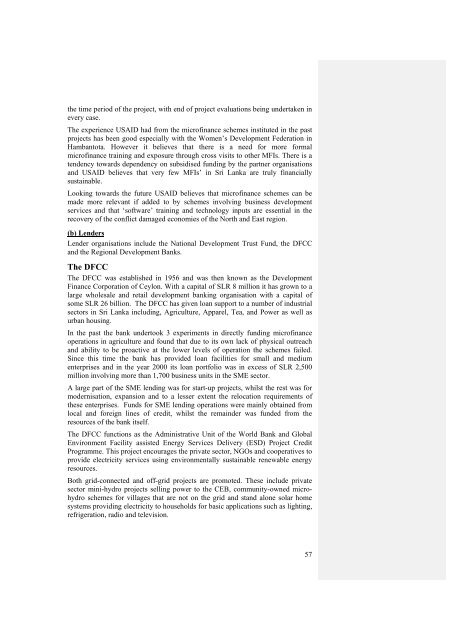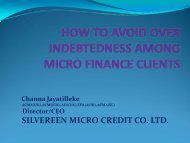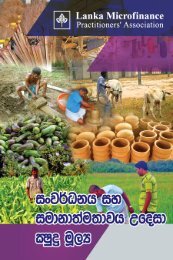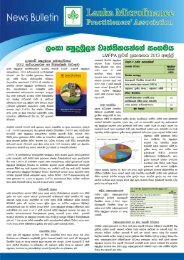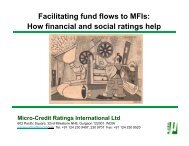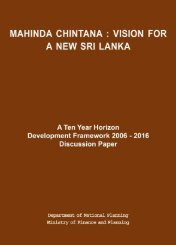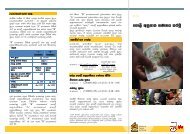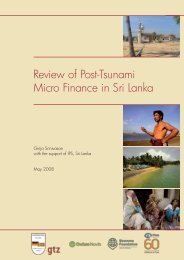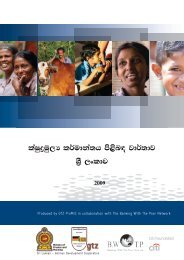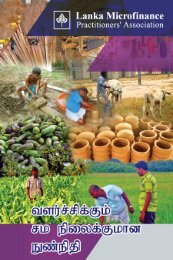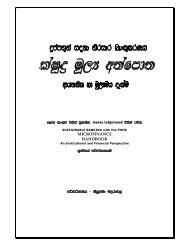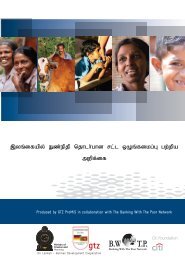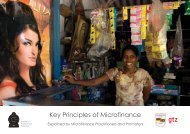National Microfinance Study of Sri Lanka: Survey of Practices and ...
National Microfinance Study of Sri Lanka: Survey of Practices and ...
National Microfinance Study of Sri Lanka: Survey of Practices and ...
Create successful ePaper yourself
Turn your PDF publications into a flip-book with our unique Google optimized e-Paper software.
the time period <strong>of</strong> the project, with end <strong>of</strong> project evaluations being undertaken in<br />
every case.<br />
The experience USAID had from the micr<strong>of</strong>inance schemes instituted in the past<br />
projects has been good especially with the Women’s Development Federation in<br />
Hambantota. However it believes that there is a need for more formal<br />
micr<strong>of</strong>inance training <strong>and</strong> exposure through cross visits to other MFIs. There is a<br />
tendency towards dependency on subsidised funding by the partner organisations<br />
<strong>and</strong> USAID believes that very few MFIs’ in <strong>Sri</strong> <strong>Lanka</strong> are truly financially<br />
sustainable.<br />
Looking towards the future USAID believes that micr<strong>of</strong>inance schemes can be<br />
made more relevant if added to by schemes involving business development<br />
services <strong>and</strong> that ‘s<strong>of</strong>tware’ training <strong>and</strong> technology inputs are essential in the<br />
recovery <strong>of</strong> the conflict damaged economies <strong>of</strong> the North <strong>and</strong> East region.<br />
(b) Lenders<br />
Lender organisations include the <strong>National</strong> Development Trust Fund, the DFCC<br />
<strong>and</strong> the Regional Development Banks.<br />
The DFCC<br />
The DFCC was established in 1956 <strong>and</strong> was then known as the Development<br />
Finance Corporation <strong>of</strong> Ceylon. With a capital <strong>of</strong> SLR 8 million it has grown to a<br />
large wholesale <strong>and</strong> retail development banking organisation with a capital <strong>of</strong><br />
some SLR 26 billion. The DFCC has given loan support to a number <strong>of</strong> industrial<br />
sectors in <strong>Sri</strong> <strong>Lanka</strong> including, Agriculture, Apparel, Tea, <strong>and</strong> Power as well as<br />
urban housing.<br />
In the past the bank undertook 3 experiments in directly funding micr<strong>of</strong>inance<br />
operations in agriculture <strong>and</strong> found that due to its own lack <strong>of</strong> physical outreach<br />
<strong>and</strong> ability to be proactive at the lower levels <strong>of</strong> operation the schemes failed.<br />
Since this time the bank has provided loan facilities for small <strong>and</strong> medium<br />
enterprises <strong>and</strong> in the year 2000 its loan portfolio was in excess <strong>of</strong> SLR 2,500<br />
million involving more than 1,700 business units in the SME sector.<br />
A large part <strong>of</strong> the SME lending was for start-up projects, whilst the rest was for<br />
modernisation, expansion <strong>and</strong> to a lesser extent the relocation requirements <strong>of</strong><br />
these enterprises. Funds for SME lending operations were mainly obtained from<br />
local <strong>and</strong> foreign lines <strong>of</strong> credit, whilst the remainder was funded from the<br />
resources <strong>of</strong> the bank itself.<br />
The DFCC functions as the Administrative Unit <strong>of</strong> the World Bank <strong>and</strong> Global<br />
Environment Facility assisted Energy Services Delivery (ESD) Project Credit<br />
Programme. This project encourages the private sector, NGOs <strong>and</strong> cooperatives to<br />
provide electricity services using environmentally sustainable renewable energy<br />
resources.<br />
Both grid-connected <strong>and</strong> <strong>of</strong>f-grid projects are promoted. These include private<br />
sector mini-hydro projects selling power to the CEB, community-owned microhydro<br />
schemes for villages that are not on the grid <strong>and</strong> st<strong>and</strong> alone solar home<br />
systems providing electricity to households for basic applications such as lighting,<br />
refrigeration, radio <strong>and</strong> television.<br />
57


